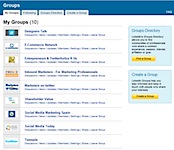The Anatomy of a Social Media Professional – and Why You Need One
I recently spoke at the Greater Manchester Chamber of Commerce breakfast where I discussed the need for a dedicated social media manager to help strategize, launch and manage a social media program.
Since many of the attendees were from smaller companies, I stressed that any business – big or small – could benefit from implementing some form of social media strategy into their organization. An example I used to help make my point was to compare Starbucks with the Crème Brulee cart in San Francisco. Both businesses are using Twitter and seeing great results to drive business to their location, but one is a multi-national chain and the other is a small food cart roaming around San Francisco. They couldn’t be more different, yet they are using the same tools to connect and engage with their loyal fans.

If you don’t think you need help managing your social media efforts, you might want to take a closer look at the time investment required to ensure it’s done well. Sure, some of you may be able to manage it all while also running your business, but to do it right, it needs to be more than an afterthought – and most executives just don’t have the bandwidth to focus on doing both jobs effectively at the same time.
You also aren’t likely to have the time to “be everywhere” – listening, engaging, responding – but a dedicated social media professional can do this for you. Consistency is crucial to ensure results. A dedicated focus on social media efforts = a quicker time to value.
You also don’t want to have a “Nelson” moment by not paying attention to your brand online. Some examples I used during the Chamber Breakfast included Domino’s Pizza and United Airlines to show the difference between a brand listening and responding immediately (Domino’s) and another that chose to ignore for more than a year (United).

So, what should you look for in a social media professional? We asked David Meerman Scott this question while attending SXSW Interactive earlier this year. You can check out the video here, but I summed it up with this intricate graphic I call “The Anatomy of a Social Media Professional.”

As David also pointed out in his interview with us, when you are seeking help with your social media efforts, it’s important that you do your homework and make sure whoever you hire has the qualifications needed to get the job done. If they aren’t out there practicing what they preach, or if they can’t point to any ROI as a result of their efforts, than you might want to keep searching.
What do you think? Do you think a dedicated social media professional is necessary in business? What qualities do you think a social media professional should have – did we miss anything in our anatomy slide? We would love to get your thoughts in the comment section below.



 Recently I attended my first
Recently I attended my first 


